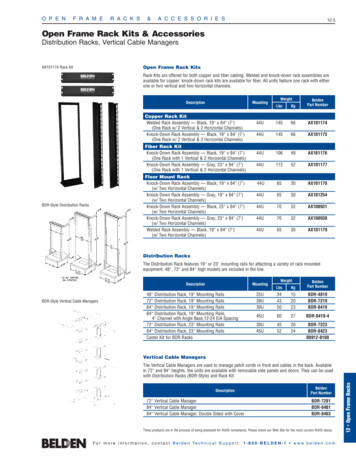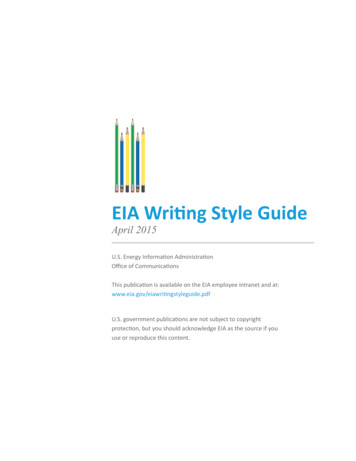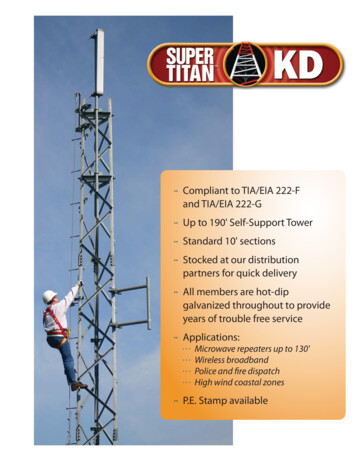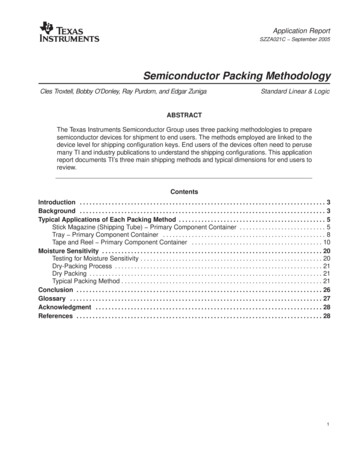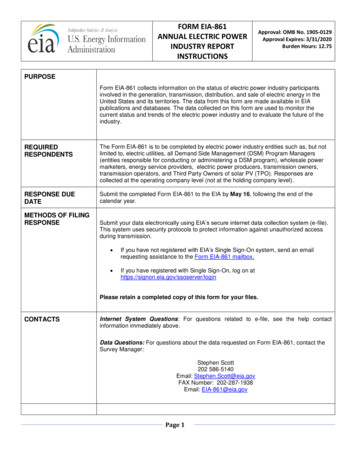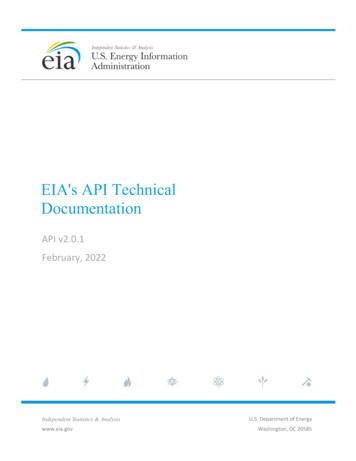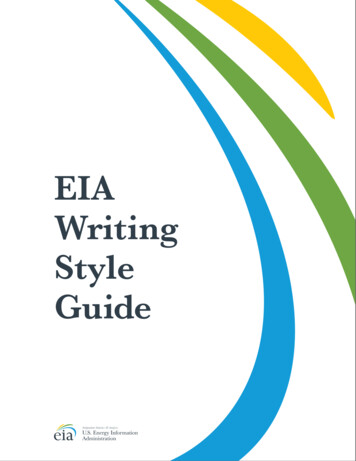
Transcription
EIAWritingStyleGuide
EIA Writing Style GuideDecember 2020U.S. Energy Information AdministrationOffice of Stakeholder Outreach and CommunicationsThis publication is available on InsideEIA and atwww.eia.gov/eiawritingstyleguide.pdfU.S. government publications are not subject to copyright protection,but you should acknowledge EIA as the source if you use or reproducethis content.
AcknowledgmentThe Office of Stakeholder Outreach and Communications extends our deep gratitudeto the EIA Writing Style Guide Working Group for their hard work and collaborationon this project. The success of this revised guide would not have been possiblewithout their professional and thoughtful input.EIA Writing Style Guide Working GroupJeff BarronOwen ComstockAli CoyleMickey FrancisMatt FrenchTim HessSara HoffSlade JohnsonApril LeeBill McNaryKristen TsaiSenior EditorChristinne GovereauEditorsHeather McDanielJulia Torres
ContentsIntroduction to the EIA Writing Style GuideChapter 1: Writing ClearlyChapter 2: NeutralityChapter 3: Common Grammatical ErrorsChapter 4: Word UsageChapter 5: CapitalizationChapter 6: NumbersChapter 7: PunctuationChapter 8: Abbreviations and UnitsChapter 9: Lists and BulletsChapter 10: Formatting Reports, Tables, and GraphsAppendix A: Scientific Writing at EIA
IIntroduction to theEIA Writing Style GuideThis style guide isan update of the editionreleased in April 2015.
PurposeWe created the EIA Writing Style Guide to help EIA writers produce consistent, accurate, andreadable content. The style guide provides guidance on style issues—including capitalization,punctuation, word usage, and tone—most relevant to EIA writing. The Style Guide primarilyapplies to all EIA external communications; however, this guidance is also useful for ensuringmore consistent and effective internal communications. For example, presentations anddocuments that are shared within EIA and across other DOE program offices should followEIA style.Language is constantly evolving, and to keep in step with best communication practices, wehave to reconsider our style choices from time to time. This update to EIA style was acollaborative effort between the EIA editors and a group of EIA writers. We invited this workinggroup to join us in considering EIA style because we wanted style decisions to make sense in theenergy context.Guidelines versus hard-and-fast rulesThe EIA Writing Style Guide is not a book of hard-and-fast grammar rules; it is guidance on clearcommunication and EIA-specific style choices.Unlike grammar, which follows universal rules, style choices include topics such as how andwhen to write out numbers, when to use the serial comma, or when to use ending punctuationfor bullets.Following uniform style preferences enhances credibility and shows users that EIA has highquality standards for both our words and our numbers.Establishing EIA styleOur goal was to find balance—between consistency and flexibility and between a conversationaltone and industry language. To achieve this balance, we formed a working group of subjectmatter experts who are also writers and reviewers. We worked together to identify six guidingprinciples for this style guide. When making style decisions, we asked ourselves:Is this guidance EssentialNeedlessly restrictiveConcise and clearDoes this guidance Match energy industry languageImprove clarityPromote a modern, conversational toneResourcesWe used three resources to inform our decisions: The Chicago Manual of Style The Gregg Reference Manual, 11th Edition Merriam-Webster dictionaryThis style guide attempts to cover most of the questions that commonly arise in EIA writing.However, this guide is not intended to be a comprehensive writing or grammar manual. If youencounter questions that this guide does not answer, consult the source material above orcontact the Office of Stakeholder Outreach and Communications.6U.S. Energy Information Administration Writing Style Guide
Changes to EIA styleWe added content that answers questions from EIA staff and covers some new style choices.We also eliminated guidance that did not meet the guiding principles the working group setfor this project. In addition, we added more EIA-specific examples to show how our guidanceapplies to EIA writing. The 10 most significant changes to the style guide are:1.2.3.4.5.6.7.8.9.10.7You don’t need to spell out certain common acronyms.The modified word usage list allows EIA writers greater flexibility.You should add an s to make an acronym plural, for example, HGLs and LEDs.Appendix A includes guidance on scientific writing at EIA.A new chapter on formatting reports, graphs, and tables provides basic guidelines forthese visual aids.An updated list of units of measurement makes finding what you need a breeze.The capitalization chapter has new guidance on how to write about census divisionsand geological formations.We updated guidance on how to write about U.S. and international currency.You should always use a colon before a bulleted or numbered list.We changed the format for source notations when we create data visualizations basedon third-party data.U.S. Energy Information Administration Writing Style Guide
1Writing Clearly
Writing clearly is a bit of an art form. Some of the decisions writers make are intuitive, notguided by a grammar rule. The Federal Plain Language Guidelines lay out the principles thatdefine the writing style of Plain Language, but like our writing style guide, the guidelinescan’t possibly cover every situation. We address some common writing issues at EIA thatcompromise clarity. You will find most of this guidance in the federal guidelines, but some arestyle choices EIA has adopted in the spirit of ensuring our writing is clear and simply written.EIA style is not only clear, but it also reflects the modern language of today’s energy industry.Although we prefer a more conversational style, the tone should be at a suitable level offormality for a federal agency.1. Consider your audience Anticipate and answer your readers’ questions. Identify your largest audience before you begin writing. Think about what they mayalready know and what they will want to know about your topic. Write to your primary audience when writing for an audience with varying degrees ofexpertise, and provide background information through hyperlinks or short parentheticaldescriptions to accommodate the part of your audience with less expertise. Whileplanning and drafting your content, consider:– Their level of technical expertise– Their depth of interest– The tasks they will perform with the information you provide The 2019 EIA website customer survey showed that 18% of our customers are first-timevisitors, 25% do not live in the United States, and 44% identify themselves as not in theenergy industry. Each year, this survey produces similar results.2. Put the Bottom Line Up Front (BLUF) Start with your main message so your readers can quickly get the most importantinformation and then decide if they want to read more. Organize your content so the information appears in order of importance, from thehighest level to supporting details. Present the familiar content first and move to new concepts later in the sentence orparagraph structure.3. Use short sentences Aim for a maximum of 15 to 20 words. Short sentences are easier to read. Consider breaking a long sentence into two shorter sentences. Eliminate unnecessary words.4. Use short paragraphs Avoid long paragraphs or large blocks of text. Long paragraphs are difficult for readersto scan. Try to write paragraphs of four or five sentences or about 75–100 words. Paragraphs asshort as one sentence are fine. Use bullets for a list with more than three items.9U.S. Energy Information Administration Writing Style Guide
5. Choose active over passive voice Use active voice most of the time. In active-voice sentences, the subject performs the action of the verb. In passive-voice sentences, the target of the action takes the subject position.Passive-voice sentences often leave out the person or group responsible for the action(also known as cut passive).ExamplesActive voice: The agency proposed new regulations.Active voice: EIA projects that oil production will increase.Passive voice: New regulations were proposed.Passive voice: Oil production is projected to increase. Use passive voice sparingly. You can use passive voice occasionally for specific purposes:– When the object of the action is your emphasis. You may also want to use this stylein headlines.ExamplesEmissions guidelines were issued by the California Air Resources Board in 1990.New Conservation Guidelines Are Adopted by the Legislature– When the person or entity taking the action is unimportant or unknown.ExampleStringent emissions guidelines were issued in 1990.6. Use parallel structure Sentences should be parallel.ExamplesParallel: Natural gas was transported via pipelines and tankers.Not parallel: Natural gas was transported via pipelines and tanker deliveries. Phrases and terms should be parallel.ExamplesParallel: Natural gas imports and crude oil importsNot parallel: Natural gas imports and imports of crude oil Verb tense should be parallel unless you want to indicate a clear shift in timing.ExamplesParallel: Smaller coal mines have had greater difficulty competing in the current marketand have been the first to close.Clear shift in timing: FERC adopted the regulations in 2010, and they will be up forreview in 2020. Bullets, numbered lists, or lists in a sentence must start with the same kind of word(noun, verb, adjective, etc.), and all must be either phrases or complete sentences.ExamplesParallel: The project director is a strong leader, a skillful politician, and an effectivemanager.Not parallel: The project director is a strong leader, a skillful politician, and he manageseffectively.10U.S. Energy Information Administration Writing Style Guide
Parallel lists: Educating the public Informing the media Updating decision makers Conducted a survey Computed the results Prepared a report7. Avoid jargon Choose nontechnical terms as much as possible. EIA’s content is accessible to a widerange of readers, from experts on your topic to novices. Explain the term simply if you must use jargon or technical language. Provide an example or an analogy. Define terms you think a nonstatistical, nonscientific reader might not understand. Youcan provide definitions by adding:––––Explanatory words either in the sentence or in parenthesesA note at the bottom of a graphA footnote or endnoteA link to the EIA Glossary, additional EIA material, or outside source Link the term, phrase, or report name itself rather than writing click here.ExampleThe full Short-Term Energy Outlook is available on EIA.gov.8. Be consistentGood writing is built on patterns, so be consistent within your content. For example, don’tcall it gasoline in some instances and motor gasoline or gas in others. Consistent terminology Consistent grammatical structure Consistent parallel structure for headings and lists9. Make your writing reader friendlyWhen faced with a choice, always err on the side of clarity. Don’t omit words in a proper noun to make the term shorter.– Include all the words in a noun to be clear.ExamplesClear: Central America and South AmericaUnclear: Central and South AmericaClear: North Dakota and South DakotaUnclear: North and South Dakota Don’t use parenthetical plurals in text or in labels and headings, such as entity(ies),agency(ies), or form(s).– Use the plural form when the possibility of one or more exists. In text, subject-verbagreement becomes a problem when you use a parenthetical plural. In labels, theparentheses are not reader friendly. Readers will understand the implied singular.ExamplesS-V agree: Reporting forms are due on the first of every month.S-V problem: Reporting form(s) [is/are] due on the first of every month.Reader friendly: Oil wells drilled in 2020Clunky: Oil well(s) drilled in 202011U.S. Energy Information Administration Writing Style Guide
Don’t use and/or. Pick one or the other.– Use either and or or for greater clarity. Most of the time you mean either or or andbut not both. Choose the one that best fits the context. If you need both words, addor both.ExamplesLess clear:Power plants in the United States most commonly use coal and/or natural gas as fuel.More clear:Power plants in the United States most commonly use coal or natural gas as a fuel.Power plants in the United States most commonly use coal and natural gas as a fuel.Power plants in the United States most commonly use coal or natural gas, or both,as a fuel. Don’t use with to link ideas or sentences.– Use a coordinating conjunction or other appropriate descriptive word to join ideasor sentences. Use with to show someone or something is accompanied by or inpossession of.ExamplesConcise: Oil production rose in the third quarter and reached a record high.Less concise: Oil production rose in the third quarter, with levels reaching a recordhigh. Don’t string together more than three modifiers with a noun because the noun can easilyget lost.– Use modifiers sparingly to avoid confusing your reader.ExamplesClear: Annual totals for electric power generated from natural gasUnclear: Annual natural gas-fired electric power generation totals Don’t use false subjects.– Sentences that begin with this, that, it, or there followed by a form of to be canconfuse readers because readers have to look for the subject in the previous sentence.– False subjects:This isThere isThere wasIt isThat isThere areThere wereIt wasExamplesClear: This change is because of the new law.Unclear: This is because of the new law.Clear: The increase in demand is a result of the weather.Unclear: It is a result of the weather.Clear: Oil prices are rising because demand is up and supplies are low. This low supply isthe result of pipeline constraints and decreased imports.Unclear: Oil prices are rising because demand is up and supplies are low. This is the resultof pipeline constraints and decreased imports.(This what? This could refer back to rising prices, increased demand, or low supplies.)10. Make your writing conversationalThe formality of your writing depends on both content and audience. Use the pronoun we instead of EIA once you establish that EIA is the actor.12U.S. Energy Information Administration Writing Style Guide
ExamplesInformal: We project oil production to increase.Formal: EIA projects oil production to increase. Use contractions.ExamplesInformal: The January STEO forecasts that oil production won’t increase next year.Formal: The January STEO forecasts that oil production will not increase next year. Use must for requirements.ExamplesInformal: In the AEO2020 Reference case, all coal-fired power plants with heat rateimprovement options must begin these projects or retire by 2025.Formal: In the AEO2020 Reference case, all coal-fired power plants with heat rateimprovement options are mandated to begin these projects or retire by 2025. Use the simplest word (see examples in Sections 11, 12, and 13). Avoid colloquial words or expressions to avoid the risk of making your writing tooinformal.ExamplesInformal: Natural gas has the upper hand in fueling power plantsFormal: Natural gas surpasses coal as the prominent fuel source for power plantsInformal: OPEC kicks the can on production cuts this yearFormal: OPEC delays a decision on production cuts this year11. Use strong verbs instead of noun phrasesEliminating unnecessary words makes your writing stronger and your sentences shorter.This list provides some examples of how to simplify a noun phrase.13Don’t use thisUse thisAfford an opportunityAllowCome to an agreement onAgreeDemonstrate a preference forPreferGive approval forApproveIn violation ofViolateIs able toCanMake a choiceChooseMake a decisionDecidePresent a summary ofSummarizePerform an analysisAnalyzeU.S. Energy Information Administration Writing Style Guide
12. Avoid redundanciesDon’t weigh your writing down with unnecessary modifiers. This list provides someexamples of modifiers we don’t need.Don’t use thisUse thisNew recordRecordOriginally beganBeganCompletely destroyedDestroyedFinal completionCompleteReason is becauseBecauseClose proximityCloseContinue to remainContinue or remainThroughout the entireThroughout13. Use hyperlinks to provide background information Use links to provide related content such as glossaries, tables, reports, and graphics. Use links sparingly throughout a report. Too many links makes the text hard to read.ExamplesIn 2020, EIA expects the United States to export about 20% of the petroleum produceddomestically. Table 4, U.S. energy consumption, provides usage data by state.You can find more information in the March 2020 Short-Term Energy Outlook. Stand-alone links are menu links or links at the beginning or end of a section, such as theLearn more links added to Energy Explained articles.Example Hyperlink enough of the text to be clear about what the link is going to.ExamplesClear: Diablo Canyon Unit 2 was taken offline on April 27.Clear: The company presented the Integrated Performance Plan in response to theflooding.Unclear: The company presented the Integrated Performance Plan in response to theflooding.Unclear: Diablo Canyon Unit 2 was taken offline on April 27. Never use click here or click here or see here as a link. Don’t write text that mentions thelink itself. Don’t underline links. The wording of a link to a publication should match the title of the publication.14U.S. Energy Information Administration Writing Style Guide
14. Avoid bureaucratic languageUse simple and specific words—not bureaucratic, clichéd, or wordy expressions.This list provides some examples of how your word choice makes your writing moreconversational.Bureaucratic or wordyaccordinglyaforementionedadditionallyas to whetherat the present time,at this point in timeat the time thatburgeoningby means lycurrentlydue to the fact thatduring the course ofendeavor toequally asequivalentfacilitatefinalizefor the most partfor the purpose offurthermoreidenticalin accordance withincentivizingincluding, but not limited toindicesinitialinitiatein order toin spite of the fact that/ofin the event thatin the month of January15Simple and specificsoas mentionedalso, in additionwhethernowwhengrowing, increasingwith, in, byability, canstopstart, beginconsists ofmakes upsonowbecauseduringtry toequallyequalhelpfinishmostlyfor, toalso, in additionsameby, following, underpromoting, encouragingincludingindexesfirststarttoalthough, despiteifin JanuaryU.S. Energy Information Administration Writing Style Guide
in the near futurein the vicinity ofit is felt thatkind ofleveragelimited numbermagnitudemandatemyriadno later thannumerouson a monthly/weekly/annual basison or before December 2on the basis ofon the part ofoptimumpreeminentsoonnear(omit)ratheruse, take advantage offew, somesizerequiremanyby, formanymonthly/weekly/annuallyby December 2based onbybestprimary, majorregardingretainsince the time whensubsequent (to)sufficientsunsetterminatethe question as to whetherthereforethe reason why is thatthe table is a list ofthustime frametime periodunderutilizeduntil such time asuponusage ofused for fuel purposesutilizeabout, of, onkeepsincenext/afterenoughendend, stopwhethersobecausethe table showssotime or periodtime or periodunderuseduntilonuse ofused for fueluse (except with refinery, pipeline,or power plant capacity)whetheraboutexceptappearswhether or notwith regard towith the exception ofwould appear that16U.S. Energy Information Administration Writing Style Guide
2Neutrality
EIA’s responsibility is to provide independent, policy-neutral information. We don’t advocate orsupport policies, industries, fuels, or trends.Sometimes our writing may seem repetitive. Using different words to vary the text may seemlike a good idea, but often the new verbs or adverbs have subtle or not-so-subtle connotations,either positive or negative.1. Use policy-neutral wordsExamplesNeutral: prices fellNot neutral: prices plummetedNeutral: production decreased, production droppedNot neutral: production was slashedNeutral: Hydraulic fracturing requires large amounts of water.Not neutral: Hydraulic fracturing requires huge amounts of water.Neutral: Natural gas production reversed its downward trend.Not neutral: Natural gas production finally reversed its downward trend.2. Avoid these phrasesUse descriptive language where appropriate, but avoid these words and phrases. A 50%increase may seem to be surging or skyrocketing, but let readers form their own opinions.ExamplesAppropriate actionBurgeoningEffective policyEnormousHugeJumpedMassiveObvious 3. Watch for these common situations that may test policy neutrality Rising or falling prices– To a consumer, rising prices are usually negative, and falling prices are usuallypositive. An energy producer may have the opposite perspective. EIA reports thetrends with neutral words to avoid seeming like we are on one side or the other. Instead of writing oil dependence, write use of foreign oil– The term oil dependence inevitably leads to discussions about energy independence.Instead of dependence, use terms such as use of foreign oil or imported oil as a shareof U.S. oil consumption. Environmental impacts of energy production and consumption– EIA can discuss impacts and list what they are, but we should not use judgmental oradvocacy words. Policies that support or do not support a fuel technology– Avoid appearing like a cheering section for a tool or technology. Just state the facts.18U.S. Energy Information Administration Writing Style Guide
3Common Grammatical Errors
1. Which and that Which and that are not interchangeable. Which is a pronoun that introduces nonessential information. Use a comma before awhich clause. That is a pronoun used to introduce essential information. Don’t use a comma before athat clause.ExamplesPower plants that burn fossil fuels emit pollutants. (Specifically, the plants that burnfossil fuels.)Power plants, which are one source of electric power, may emit pollutants(In general, power plants are one source of electric power.) In many cases, you don’t need to include that. Omit that where it doesn’t introduce adependent clause that modifies a clause or noun. The primary thing to remember is ifthe sentence makes sense without that, leave it out.ExampleEIA forecasts [that] the price of a barrel of oil will go down in 2021.2. Possessives When writing about a country or state, don’t make the country or state an adjective(modifier) when it creates clarity issues.ExamplesDo this: Colombia’s oil production (sounds like the country)Not this: Columbian oil production (sounds like a type of oil) When writing a singular noun that ends in s, use apostrophe s (‘s).ExamplesKansas’s legislatureYour boss’s approvalNatural gas’s share When writing a plural noun that ends in s, use only an apostrophe.ExampleRenewables’ share Place names ending in a plural noun that ends in s only require an apostrophe.ExampleThe United States’ policy (states is a plural noun that ends in s)3. PronounsCountries, companies, or ships Use it when referring to companies, countries, or ships.ExamplesMexico imports most of its natural gas.The Long Range ship is used globally because of its ability to access most large ports.Singular theyUse they as a plural pronoun, never singular. Chicago offers several ways to make yourwriting gender neutral to avoid the awkward construction of he or she.20U.S. Energy Information Administration Writing Style Guide
Omit the pronoun.ExamplesNot this: The analyst will update the records once all power plants have transferredtheir monthly data to her.This: The analyst will update the records once all power plants have transferred theirmonthly data. Repeat the noun.ExamplesNot this: An EIA writer should be policy neutral to maintain his or her credibility.This: An EIA writer should be policy neutral to maintain credibility as an EIA writer. Use a plural antecedent.ExamplesNot this: An EIA writer should be policy neutral to maintain his or her credibility.This: EIA writers should be policy neutral to maintain their credibility. Use an article instead of a personal pronoun.ExamplesNot this: An EIA writer should always double check his or her data.This: An EIA writer should always double check the data. Use the relative pronoun who (works best when it replaces a personal pronoun thatfollows if).ExamplesNot this: Employers presume that if an applicant can’t write well, he won’t be a goodemployee.This: Employers presume that an applicant who can’t write well won’t be a goodemployee. Use the imperative mood.ExamplesNot this: An EIA writer must ensure the data he or she uses are accurate.This: Ensure the data in EIA writing are accurate.Indefinite pronounsIndefinite pronouns can be singular, plural, or both, depending on MoreMostWho, which, that Use a singular verb when each and every come before two or more subjects joined by and.ExamplesEvery solar and wind facility has an annual operating budget.Each solar and wind facility submits a monthly report.21U.S. Energy Information Administration Writing Style Guide
Use a plural verb when each follows a plural subject.ExampleCoal and natural gas generation each have increased. For pronouns that can be either singular or plural, use a verb tense to match the nounthat the pronoun references.ExamplesAll of the analysis is complete.All of the reports are submitted. Use a singular verb to compare two singular subjects through either.or or neither.nor.ExamplesNeither my officemate nor I was planning to attend the conference.Either my officemate or my boss was the last person to leave. Use a plural verb to compare plural subjects through either or or neither nor.ExampleNeither the team leaders nor the team members agree with the data. Use a verb tense that matches the nearest subject when subjects are singular and plural.ExamplesNeither the team leader nor the team members agree with the data.Neither the team members nor the team leader agrees with the data.4. Subject-verb agreement in tricky situationsCollective and mass Collective and mass nouns represent a group or collection of people or things. Collectivenouns are countable and mass nouns are non-countable. When a collective noun acts as a unit, use a singular verb. When a collective noun actsseparately, use a plural verb.ExamplesEIA staff is presenting the IEO2020 at a press conference this afternoon.EIA staff are responsible for their own time and attendance records. A mass noun is non-countable because it is either abstract or refers to an aggregate ofpeople or things taken as an indeterminate whole, for example, luggage.– The primary difference between mass nouns and collective nouns is that mass nounsalmost never take indefinite articles and typically do not have plural forms.ExampleThe data show increasing evidence (mass noun) that production will slow later this year. Base your plural or singular verb on the subject of the sentence and not on anyintervening clauses.ExamplesThe rig count for oil wells is at a record high.Regional prices for gasoline in the Midwest are at a record high.22U.S. Energy Information Administration Writing Style Guide
4Word Usage
Commonly misused words Definition and exampleabout/around/approximately: nearly accurateapproximately/roughlyor exact.(used with numbers)About does not convey thecloseness to accuracy thatapproximately does.Use about/around whenestimating.Definition and exampleabout/around: near to, close to.roughly: lack gentleness orrefinement.Roughly is too informal for EIAwriting.Use approximately whenrounding.Account for/make ile24account for: to form a part ofsomething.make up: to form by fittingtogether or assembling.Comprise is too formal for EIAwriting.Compose is too formal for EIAwriting.ExampleNatural gas accounts for[comprises] 50% of fossil fuelconsumption.ExampleOPEC’s membership is made up[composed] of 12 countries.affect: to influence.effect: a result (as a noun); tobring about, to accomplish (asa verb).ExampleThe hurricane affected fivestates.ExampleThe effects of the hurricaneincluded widespread poweroutages and flooding.although: in spite of the factthat, even though.while: at the same time.Though is too formal for EIAwriting.While when you meanalthough is less clear and lessreader friendly.Use although when you wantto emphasize a contrast.Use while to signal that you aretalking about time.ExampleAlthough many of these damshave hydroelectric generators,only a small number werebuilt only for hydropowergeneration.ExampleBetween 2005 and 2017,total U.S. electricity generationincreased by almost 4% whilerelated CO2 emissions fellby 27%.U.S. Energy Information Administration Writing Style Guide
Commonly misused words Definition and examplealternate/alternativealternate: to change back andforth; every other one in aseries.because/asbecause/sincebecause (of)/due toDefinition and examplealternative: a choice betweendifferent options.ExampleThe power plant alternatesbetween using renewablesources of generation andnatural gas.ExampleEIA considered threealternative methods forcollecting data.because: cause and effect;for that reason.as: indicates events areoccurring at the same time.ExampleOil production is decreasingbecause crude oil storagelevels are at an all-time high.ExampleOil production has decreasedas storage levels have risen.because: cause and effect; forthat reason.since: from a certain time.Use because when
6 U.S. Energy Informaion Aminraon Wrng Sye e Purpose We created the EIA Writing Style Guide to help EIA writers produce consistent, accurate, and readable content. The style guide provides guidance on style issues—including capitalization, punctuation, word usage, and tone—most relevant to EIA writing. The Style Guide primarily
